Innovation in Tropical Forest Conservation: Q&A with Susie McGuire and Dr. Ed Louis Jr.
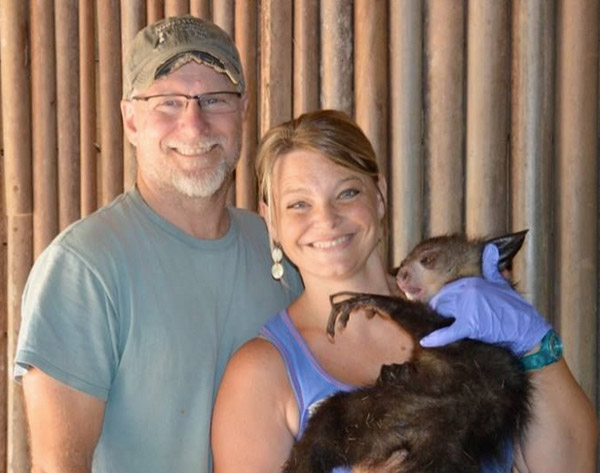
Ed Louis (left) and Susie McGuire (right) with aye-aye. Photo courtesy of the Madagascar Biodiversity Partnership and Conservation Fusion.
Susie McGuire and Dr. Edward Louis Jr. are the powerhouse team behind the Madagascar Biodiversity Partnership (MBP), an NGO that involves local residents-both human and primate- in reforestation efforts in Madagascar.
A conservation geneticist and veterinarian by training, Ed Louis has discovered 21 lemur species and successfully reintroduced two species of locally extinct lemurs back into the wild. He is currently the Director of Conservation Genetics at the Omaha Henry Doorly Zoo and the Founder and Director of the Madagascar Biodiversity Partnership (MBP). Susie McGuire is the founder and Creative Director of the education focused NGO, Conservation Fusion.
 The greater bamboo lemur is currently listed as Critically Endangered. Only around 500 individuals survive in the wild. Photo by: Rhett A. Butler. |
“The concept of the EPRP [ MBP’s Education Promoting Reforestation Program] is simple,” Susie McGuire told mongabay.com. “Forest restoration begins with the lemurs, as seeds are collected from their feces…Upon maturation, the trees will be planted systematically, and subsequently managed and monitored by local people! Community members participate in Conservation Fusion educational activities to better understand the MBP’s reforestation plan. Land use will be allocated to include 15 percent fruiting trees, 30 percent cash crops (grown for selective logging and other production) and the remaining 55 percent will be dedicated to forest restoration.”
The MBP has taken this community conservation process one step further and gone digital. With the help of the University of Nebraska at Omaha, MBP developed an app to track individual contribution to reforestation. Using the app, local resident register with MBP and earn credits for planting trees.
“These credits are linked to their reforestation profile,” says McGuire, “and as they accumulate credits they can redeem them for items such as fuel-efficient rocket stoves and solar light kits. This has prompted the more entrepreneurial-minded people to request incentive items to help build their own businesses. . For example, a women’s association planted trees to earn a sewing machine and an association of honey-collectors is in the process of arranging a special program to earn a honey separator.”
Through the Education Promoting Reforestation Program reforestation program over 180,000 trees have been planted, many by local children from nine participating schools. The MBP now has four permanent field sited in Madagascar, which harbor critically endangered wildlife and provide a training ground for young scientists and conservationists as well as seasoned researchers.
An Interview with Susie McGuire and Dr. Ed Louis Jr.

Children planting trees. Photo courtesy of the Madagascar Biodiversity Partnership and Conservation Fusion.
Mongabay: What is your background? How long have you worked in tropical forest conservation and in what geographies? What is your area of focus?
Ed Louis Jr: I am a conservation geneticist with a PhD in molecular genetics and veterinary degree focused on field medicine. Primarily concentrating on island biogeography, my work has spanned the globe from Galapagos, Philippines, Indonesia, and Thailand and finally taken a strong hold in Madagascar where I have been leading field teams, working with Malagasy students and collaborating with innovative scientists for the past 15 years. Currently, I am the Director of Conservation Genetics at the Omaha Henry Doorly Zoo and the Founder and Director of the Madagascar Biodiversity Partnership (MBP), a Malagasy NGO. Areas of focus have become leveraging local biodiversity to support community-based programs benefiting both the local people and the environment.
The Madagascar Biodiversity Partnership continues ground-breaking molecular genetic research carried out at the Omaha Zoo’s Center for Conservation and Research and has implemented numerous community outreach programs promoting sustainable, responsible actions in Madagascar. Our leadership, innovation and dedication has resulted in the discovery of 21 lemur species new to science, a successful re-introduction of two species of locally extinct lemurs with three generations of healthy offspring, and technology transfer with the graduation of more than 40 Malagasy students. Additionally, our team has spearheaded the development of affordable fuel-efficient stoves and biofuel briquettes, introduction of solar panels and lights to local communities and the implementation of one of the most novel reforestation efforts ever, employing the local forest residents (a.k.a, “lemurs”) to provide the basis of the program. Each of these programs is reinforced with a multifaceted education component through a partnership with Conservation Fusion, an international NGO.
Susie McGuire:I
launched Conservation Fusion in 2010, and my current focus is on both education and the island of Madagascar.
I am the Founder and Creative Director of Conservation Fusion and am passionate about animals, science, environment, people, and changing the world, so running CF , an international NGO, is the perfect niche.
The organization’s mission is “Educating to Build and Strengthen Our World.” This is accomplished by incorporating fun, interactive, hands-on education methods focused on conservation. My team and I have linked communities on a local and global scale to find solutions to conservation challenges. Our work has resulted in multiple “o-rama” learning bonanzas, service learning connections, book publications, peer reviewed scientific articles and, as a direct result of the work of our team and partner NGO’s work on the island of Madagascar, the removal of a Critically Endangered lemur species from the IUCN Red List.
Local and international foundations, the BBC, and multiple zoos from Australia to Boise Idaho have jumped on board to support the mission and vision of this growing organization. We strive to think outside the box to find innovative ways to sustain non-profit organizations and empower others to change the world.
Mongabay:Are you personally involved in any projects or research that represent emerging innovation in tropical forest conservation?

Ed Louis with black and white ruffed lemur. Photo courtesy of the Madagascar Biodiversity Partnership and Conservation Fusion.
Susie McGuire and Ed Louis: Yes! The Madagascar Biodiversity Project has established four permanent sites in Madagascar. These regions each harbor Critically Endangered lemurs and/or tortoises at the brink of extinction. The beauty of the MBP program is that they have embraced the notion that successful conservation programs must have an education component and the support of the local community. By educating and empowering local residents and providing tangible “green” technologies in exchange for sustainable conservation actions, community members become integral stakeholders in protecting the biodiversity. It is a win-win situation for us all.
Ecosystems management is a hot topic and the MBP is addressing issues such as clean water and sanitation, renewable resources and green technology with local Malagasy residents in the hope that with an understanding of these principles, these four sites can go directly from no infrastructure (water, power etc) towards sustainability for both humans and the endangered wildlife. This is a win-win! Also, a grassroots reforestation program that began at the MBP research site in Kianjavato has expanded into multiple satellite nurseries that have been built, or are being built, and wells to provide a water source for seedlings. Through the program over 180,000 trees, have been planted, many by local children from the nine schools participating in CF education programs.
The education program is multi- faceted and includes workshops for students, teachers, village elders, and government officials, both locally and regionally. Conservation camps and “movie nights” also reinforce the reforestation objectives and focus on the benefits to both humans and biodiversity in this unique region of the island. The MBP works with multiple partners, including CF, which compliment the research endeavors of the MBP.
In the dry spiny forests, the MBP has a permanent site in Lavavolo where they have collaborated with CF to provide Hippo rollers to local community members to provide a more efficient transport of water. This is a life-changing solution to the lack of water available in the region while allowing women and children an opportunity to free up time spent collecting water.
The infrastructure and research components for reforestation and state-of-the-art lemur conservation are in place with the MBP and CF providing community members, governmental officials, teachers, and kids ownership and pride in protecting their natural resources.
Mongabay:What do you see as the biggest development or developments over the past decade in tropical forest conservation?
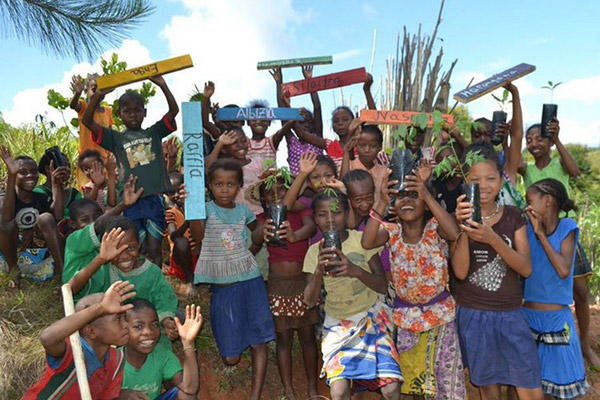
Children from a school in Kianjavato planting trees. Photo courtesy of the Madagascar Biodiversity Partnership and Conservation Fusion.
Susie McGuire:Learning that it is possible and it can be done at a local level using native trees. When local community members are directly involved and have a stake in what is happening, many small things can add up to a big change. There are many well intentioned organizations with big dollar programs, however, many of them just give a hand-out which does not promote local pride, accountability or investment and thus often leads to dependency. We strive to include local community members, stakeholders and kids in the decisions that will shape their future.
Mongabay:What’s the next big thing in forest conservation? What approaches or ideas are emerging or have recently emerged? What will be the catalyst for the next big breakthrough?
Susie McGuire:The next big thing in forest conservation is accountability. This applies to philanthropists, NGOs and the communities on the ground. Dr. Louis and the Madagascar Biodiversity Partnership team are developing a reforestation project that includes a wide range of tree species that provide a spectrum of services from fruit and timber production to no-harvest zones of native trees that replace lost ecological services due to deforestation. To be successful, difficult issues cannot be sidestepped such as land tenure and defining consequences for clearing reforested land to be enforced by the participating communities.
It is the responsibility of NGOs, researchers, and philanthropists to develop the foundation for forest conservation programs drawing on experiences and resources not accessible to the target audience to initiate a dialogue defining expectations for everyone. Working through this process, it becomes clear that deforestation is driven by a diverse range of community needs, not all of which can be met by one organization. The beauty of this realization is that NGOs can work together, each within their own area of expertise.

The aye-aye is listed as Endangered by the IUCN Red List. Photo by: Rhett A. Butler.
MBP has partnered with Conservation Fusion. CF has reoccurring programs at MBP research sites to educate people on how forests ensure a healthy future by gathering rain, providing food and medicines, and holding back the soil during Madagascar’s annual cyclones. CF works closely with local teachers providing training and networking opportunities. Village educators, for the first time, visit the diverse regions of Madagascar and talk with teachers in those areas sharing challenges and successes. These teachers help their communities to connect with the message of forest conservation and when people understand the “why” behind their actions, they are more likely to participate in following laws and re-building forests.
MBP strives to encourage broad community participation, which has resulted in more than 1,000 people planting trees in one commune alone. This pushed MBP to the next step; this hands-on grassroots reforestation work is going digital. To make this possible, MBP sought assistance, and collaborated with the University of Nebraska at Omaha, in the development of an application to track an individual’s contribution to reforestation in Madagascar. This application allows local residents to register with the MBP to plant trees in their villages. As they plant trees they earn conservation credits. These credits are linked to their reforestation profile, and as they accumulate credits they can redeem them for items such as fuel-efficient rocket stoves and solar light kits. This prompted the more entrepreneurial-minded people to request incentive items to help build their own businesses. For example, a women’s association planted trees to earn a sewing machine and an association of honey-collectors is in the process of arranging a special program to earn a honey separator.
Eventually, the communities working with MBP will have the skills to sustain their forests and opportunities to have built businesses. The penultimate goal of MBP is to give communities a hand up, not a hand out, and in the process unite thousands of neighbors on an endeavor that ends with an intact ecosystem, improved education and independence.
Mongabay: Can you give an overview of the Madagascar Biodiversity Partnership’s Reforestation Program? In what ways is this program innovative?

Planting trees on the hillsides of Madagascar. Photo courtesy of the Madagascar Biodiversity Partnership and Conservation Fusion.
Susie McGuire: The Education Promoting Reforestation Program (EPRP) is based upon the germination and planting of seeds collected from the feces of the black and white ruffed lemur (Varecia variegata) a natural seed disperser. The concept of the EPRP is simple. Forest restoration begins with the lemurs, as seeds are collected from their feces. This novel approach will be applied to reforestation efforts as community members learn proper techniques associated with species-specific germination and care for seedlings in the nursery. Upon maturation, the trees will be planted systematically, and subsequently managed and monitored by local people! Community members participate in Conservation Fusion educational activities to better understand the MBP’s reforestation plan. Land use will be allocated to include 15 percent fruiting trees, 30 percent cash crops (grown for selective logging and other production) and the remaining 55 percent will be dedicated to forest restoration.
The Kianjavato community consists of 98 percent subsistence farmers, dependent upon the forest to meet basic needs such as food, water and shelter. The cultural practice of slash and burn agriculture (tavy) has left a denuded landscape, that can no longer sustain agricultural practices required to feed the subsistence farmers in the region.
While the Kianjavato Classified Forest is a non-protected site on paper, the local community has pledged to protect lemurs and rebuild forest habitat from the ground up as a result of education programs and tangible benefits. The best way to measure success is to evaluate the populations of endangered lemurs in the Kianjavato region. Recent numbers from our partners at the award winning Madagascar Biodiversity Partnership (MBP) confirm lemur populations are steadily increasing. In 2011, data showed 21 black and white ruffed lemurs offspring and 24 greater bamboo lemur (Prolemur simus) babies. Perhaps even more exciting was the verification of an aye-aye (Daubentonia madagascariensis) offspring, which is under behavioral monitoring on a daily basis. This novel information is being collected by the MBP as they observe the mother and the young aye-aye emerge nightly from their nest. To date, this is the first data collection and observation of a birth of this species in the wild! Subsequently, the team has witnessed the birth and rearing of two additional aye-aye offspring.
Our educational outreach information emphasizes the effects of deforestation directly impacting people’s daily lives such as reduced water, drought, erosion and poor crop production. Furthermore, studies confirm when local people realize the benefits forest resources provide such as food, shelter, medicine, clean air and water, they are motivated towards conservation.
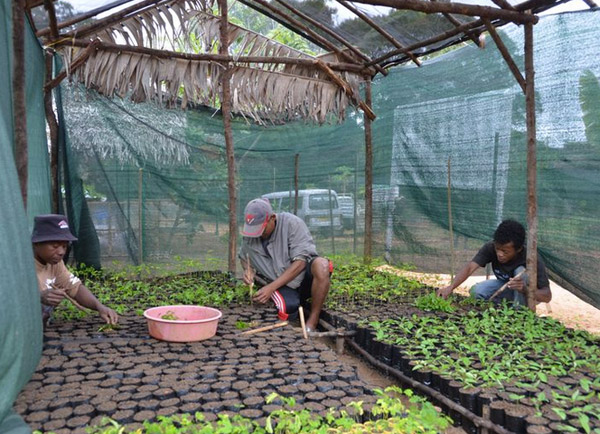
Seedling nursery. Photo courtesy of the Madagascar Biodiversity Partnership and Conservation Fusion.
Related articles
Over 800 species added to IUCN threatened list, including 44 lemurs
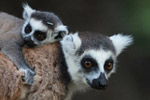
(06/16/2014) Experts have added 817 species to the threatened categories of the IUCN Red List in the latest update. Those added include 51 mammals—mostly lemurs—and over 400 plants. The new update finds that over 90 percent of lemurs and 79 percent of temperate slipper orchids are threatened with extinction.
Singapore intercepts massive illegal shipment of Madagascar rosewood

(06/03/2014) Authorities in Singapore have made the largest-ever international seizure of rosewood logs, providing further evidence that industrial-scale smuggling of Madagascar’s rainforest timber continues despite an official ban on the trade. Details of the seizure remain sparse since the investigation is still active, but leaked correspondence between officials in Madagascar indicates that the shipment amounts to 3,000 tons, or more than 29,000 illicit rosewood logs.
Next big idea in forest conservation? Linking public health and environmental degradation
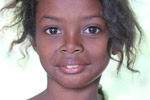
(05/22/2014) Dr. Christopher Golden is an explorer on a mission. As both an epidemiologist and ecologist, he is investigating and expanding the interface between human and ecosystem health. This year, Golden was appointed the Director of Wildlife Conservation Society’s HEAL (Health & Ecosystems: Analysis of Linkages) Program.
Lemur expert becomes first woman to win top conservation prize

(05/17/2014) Lemur expert Patricia C. Wright has become the first woman to win the prestigious Indianapolis Prize, an award granted every two years for achievement in wildlife conservation. Wright was chosen for her contributions to wildlife conservation in Madagascar, where she’s worked with lemurs for nearly 30 years.
Amphibian pandemic may have hit Madagascar, hundreds of species at risk of infection

(04/11/2014) Madagascar is one of the world’s hotspots for amphibian diversity, home to so many frog species that many of them don’t even have names. But soon the island may also harbor a fungus causing drastic declines – even extinctions – of frogs around the world. Ironically, the wildlife trade that’s often blamed for helping spread the disease may also give scientists a chance to prevent it.
Madagascar lemurs share spotlight with primatologist in new IMAX film
(04/03/2014) Tomorrow’s opening of the IMAX film Island of Lemurs: Madagascar showcases not only endangered primates, but one of Madagascar’s top conservationists: primatologist Patricia C. Wright.

(03/20/2014) One of the world’s biggest populations of greater bamboo lemurs (Prolemur simus)—sometimes known as the panda lemur—has doubled in just three years, giving conservationists new hope that the species can be kept from extinction. With the recent arrival of twenty babies, a community conservation project run by the Aspinall Foundation has boosted the local population to over 100 individuals in Andriantantely, one of Madagascar’s only surviving lowland rainforests. Greater bamboo lemurs are currently categorized as Critically Endangered, though they were once believed extinct until hidden populations were uncovered in the 1980s.
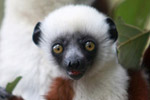
(02/20/2014) Due to the wonderful idiosyncrasies of evolution, there is one country on Earth that houses 20 percent of the world’s primates. More astounding still, every single one of these primates—an entire distinct family in fact—are found no-where else. The country is, of course, Madagascar and the primates in question are, of course, lemurs. But the far-flung island of Madagascar, once a safe haven for wild evolutionary experiments, has become an ecological nightmare. Overpopulation, deep poverty, political instability, slash-and-burn agriculture, illegal logging for lucrative woods, and a booming bushmeat trade has placed 94 percent of the world’s lemurs under threat of extinction, making this the most imperiled mammal group on the planet. But, in order to stem a rapid march toward extinction, conservationists today publicized an emergency three year plan to safeguard 30 important lemur forests in the journal Science.